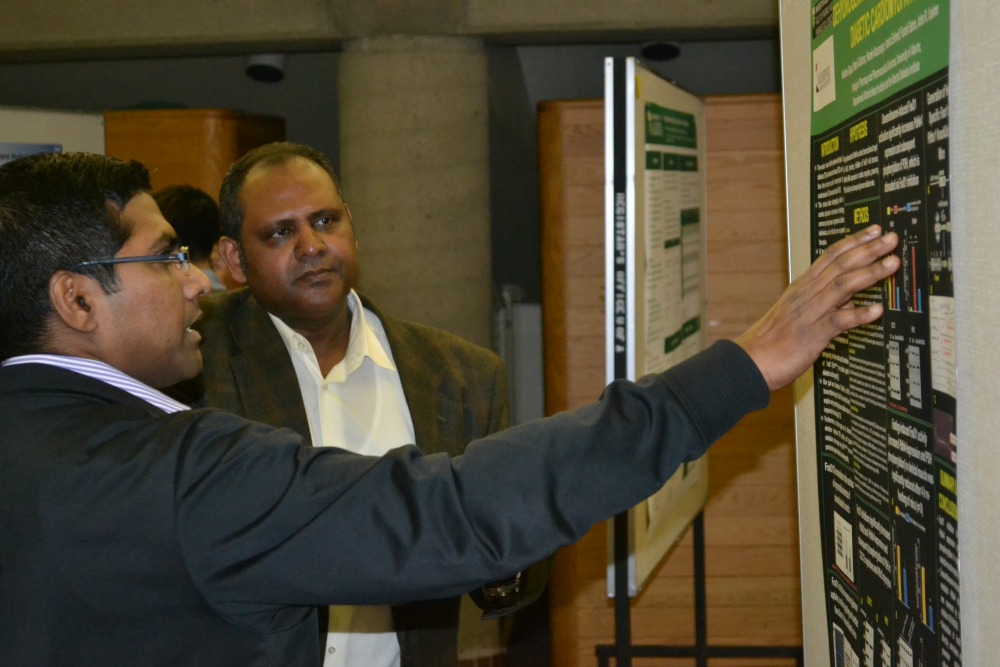
Presenting cutting-edge research: From left, post doctoral fellow Keshav Gopal talks with Faculty of Pharmacy and Pharmaceutical Sciences' professor Ayman El-Kadi about his poster presentation at the faculty's annual Research Day event.
Pharmaceutical companies must adapt to use new technologies at their disposal when developing new drugs to improve their rate of success for new molecular entities (NMEs).
The comment was part of the keynote address given by Pharmacy alumni Majid Vakilynejad, an expert in quantitative pharmacology for Takeda Pharmaceutical Company, at the faculty's annual Research Day event. Vakilynejad spoke about model based drug development and enhanced quantitative decision making in the pharmaceutical industry to faculty and students.
Vakilynejad said the success rate of developing NMEs is very low for most companies and they need to take a more strategic approach to pharmacokinetics.
"Using mathematical models to do simulation for drug development is essential and it's here to stay," says Vakilynejad. "They are an essential part of drug development in using a more quantitative approach and taking us from trial and error methods to developing drugs to a more rational approach of drug development."
Vakilynejad was one of three guest speakers at the event which focused on the theme: Translating pharmacokinetics from the bench to the clinic. Pharmacokinetics refers to the branch of pharmacology concerned with the movement of drugs within the body.
He said when companies are using model-based drug development, they need to take advantage of the computational abilities available and use more mechanistic models to better understand the biology of drug development.
"There is a very low NME success rate in drug development," he says. "Drug development is a continuous process. You need to find the right pathway, right target, right molecule, right dose and right patient in order to be successful." He noted his company Takeda is starting to collaborate more with other companies and academic institutions to build models of drug development to improve the success rate.
Research Day allows the faculty to focus on cutting-edge research in the profession and also gives undergraduate and graduate students a chance to present their research through poster and podium presentations
"This year, we had a very good turnout and real engagement from the students - both graduate and undergraduate," says Sherif Mahmoud, Co-Chair, Research Day Organizing Committee. "Our poster presentations were up about 20 per cent from last year, so we're proud of our students for being so involved."
Students won awards based on their posters and presentations. The awards were made possible by the generosity of Dr. Leslie Chatten, professor emeritus and in memory of Wu Hong, a former graduate student.
Two additional speakers - faculty professor Dion Brocks and clinical assistant professor Sherif Mahmoud - made presentations on the same theme.
Brocks' presentation - obesity research from the clinic into the lab setting - took the day's theme in the other direction. His study of the drug metformin, the most widely prescribed anti-diabetes drug in the world, looked at the hypothesis that there would be less drug absorbed from the intestine in patients that underwent gastric bypass surgery, which is a highly effect procedure used to allow severely obese patients to lose weight. Some unexpected findings appeared from the study, however. "We saw that in fact the gastric bypass patients actually had more drug absorbed. Even more surprisingly, they had a faster elimination of the drug into the urine than in a group of obese patients that were not given the surgery," says Brocks. "It appeared that obese patients that are not experiencing weight loss have lower levels of proteins that can absorb and eliminate metformin than lean and surgically treated obese patients".
Brocks then asked: How does obesity impact the transport of a drug through the body? To answer the question, he took his test results back into the lab with animal studies and confirmed that animals given high calorie diets had altered levels of not only transport proteins, but also metabolizing enzyme levels in the liver and the kidneys. These findings imply that obese patients might have to be dosed differently with drugs than patients who are not obese.
Sherif Mahmoud's presentation focused on the dosing and monitoring of antiepileptic drugs (AEDs) in patients undergoing continuous renal replacement therapy (CRRT), an example of utilizing pharmacokinetics in clinical practice. He explored factors affecting AEDs removal by CRRT in three types of patients who could be admitted into an intensive care unit: those who are on pre-existing AEDs and upon start of CRRT, seizure control might be compromised; those who are newly started on AEDs for seizures or status epilepticus and emergent seizure control is needed; and those who are admitted for AEDs overdose or toxicity and CRRT might have a role in AEDs removal.
"We concluded that protein binding, route of AEDs elimination and CRRT dose are the most important factors affecting drug removal by CRRT which could be used as a guide in AEDs dosing" says Mahmoud. "We need to do more studies on this research," says Mahmoud. "There is no sufficient evidence to provide robust dosing recommendations of AEDs in patients undergoing CRRT."